

Odeline Billant, Doctorante, UMR LEMAR, Université de Bretagne Occidentale (UBO), Brest

Marie Bonnin, Directrice de recherche, IRD, UMR LEMAR, Université de Bretagne Occidentale (UBO), Brest

Abstract
Plastic has become central to consumption patterns throughout the world and ubiquitous in natural environments these last decades. It has major environmental and socio-economic direct and indirect effects. Facing this threat, legislators haven’t stayed idle. Throughout the world, numerous legal texts have been adopting regulating the type or plastic bags or uses.
The aim of this article is to explore the diversity of strategies implemented by a set of countries to tackle a same source of pollution, plastic bags. The content of the legal text, the definitions it proposes, the objects designated and the legal instruments designed to induce behavioural change are determinant factors of the fate and effect of the texts. These elements are here analysed as the comprehensiveness of the text, which is the focus of this article.
Based on the analysis of the legal texts of seven countries (France, Ireland, United Kingdom, Senegal, Cape Verde, United States of America and Brazil) sustained by a relational database, this article develops a quantitative approach to the analysis of environmental law, and contributes to the emergence of a new legal research method called « Numerical Comparative Law.
In the last decades, plastic became central to consumption patterns throughout the world[1] and ubiquitous in natural environments, with major environmental and socio-economic direct and indirect effects[2]. Plastic bags have long been massively distributed in sailing outlets and became an icon of plastic pollution. Awareness of the potential damages to health and the environment of this new source of pollution was raised and transformed into regulations across the world.
This study is based on the analysis of the legislative path taken towards the regulation of plastic bags by seven countries: France, Cape Verde, Senegal, Ireland, United Kingdom, United States of America and Brazil[3].
A diversity of strategies can be implemented to tackle a source of pollution. Taking plastic pollution as an example, one could collect plastic in the environment[4], focus on direct collection and treatment[5] or limit single-use. The regulation of plastic usages is what is considered of interest here. Dealing with a water leakage, no plumber would base her long-term strategy on buckets (primary collection) or towels (retrospective collection). Rather, the plumber’s wisdom leads her to cut off the tap first. If less plastic is produced or used, less energy will be needed to recycle the waste or recover it in the environment[6]. From an environmental-protection standpoint, this solution looks as the most effective and straightforward of all three. Therefore, the analysis developed here focuses on strategies developed by countries to cut off plastic pollution at the source, upstream from its production or use rather than downstream of its usages.
Out of the seven studied countries, all have been engaged towards plastic bags regulation and have followed this approach. This observation hides variations on three levels: the year the first regulations were adopted, whether the adoption process is achieved and the stability of the approaches through time.
In 1997, Charles Moore discovers the Great Pacific Garbage Patch [7]. Four years later, Ireland is this first country of this study and one of the first in the world to regulate plastic bags, in 2001[8]. More than a decade later, the years 2014-2015 witness an acceleration of the adoption of plastic bags regulations in the world[9] like in the countries of our study. In 2014, Scotland adopts the Single Use Carrier Bags Charge[10] and in 2015, England adopts the Single Use Carrier Bags Charges Order[11] closely following Ireland’s approach. In 2015 Senegal[12], France[13] and Cape Verde[14] adopts loi and lei banning plastic bags. Brazil and the United States of America appear as two exceptions. As for Brazil, no regulation has been adopted to date by the State of Sao Paulo[15]; the State of Pernambouco[16] adopted a lei[17] regulating plastic bags in 2019 but it was revoked the same year. In the United States of America (USA), two States are concerned by this study: Texas and Florida. Plastic bag bills have been initiated in 2011[18] for Texas and 2019[19] for Florida, but none of these regulations were adopted, nor rejected. The procedure is currently postponed, unclear as to whether or when it will be continued.
Although legal text adoption is an essential step for law enforcement, it is not sufficient. The fact that a text is adopted doesn’t automatically mean that the text is likely to have an effect on the issue it aims to address, and even less enforced[20]. The content of the legal text, the definitions it proposes, the objects designated and the legal instruments designed to induce behavioural change are determinant factors of the fate and effect of the texts. These elements are here analysed as the comprehensiveness of the text. The text must additionally carry the necessary legal force to induce change. The text must be entered in force, be enforceable, induce behavioural change. These elements are here encompassed in the analysis of forcefulness. Summed up, the texts must address the issue both comprehensively and forcefully to be likely to have an effect on the targeted pollution.
Following this prism, this article aims to compare the strategies designed by seven countries to tackle a common source of pollution, plastic bags, through the analysis of the comprehensiveness of the legal texts adopted. The study of forcefulness, still undergoing, will be dealt with in further research. The strength of a chain can be measured by the resistance of its weakest link. Comprehensiveness acts as the first link of the chain by which law is applied. As such, its study is essential. The study of forcefulness then provides information on the potential of change embodied by the text. Measuring its enforcement on the ground and its effectiveness (how much it contributes to resolve the issue it aims to address) are further steps to determine the role law plays to protect the environment which are not addressed here.
By using quantitative data, this article contributes to the emergence of a new legal research method called “Numerical Comparative Law”[21]. This approach is a variant of the research methodology proposed by Professor Prieur in his book on legal indicators[22]. Building on past obstacles[23] and seizing the opportunities offered by technological progress and the specificities of environmental law, we attempt here to initiate a research approach in numerical environmental law based on quantitative indicators combined with a qualitative analysis of the comprehensiveness of the law.
Comprehensiveness guarantees that the issue at stake—here plastic pollution—will be dealt with in a holistic manner. It embraces two essential elements of any legislation: the definition of the objects of the rule (I), and the design of the legal instruments it implements (II).
I. Untying the Gordian knot: scope of the objects
An entry point to the reflexion on a source of pollution can be to determine whether the problem lies in the substance in itself (here plastic), or its use (from which stems its quantity).
Therefore, legislators have two avenues to protect the environment from plastic pollution: regulate the characteristics of plastic bags (A) and control its availability or usages (B). As we will see, defining plastic bags is genuinely a Gordian knot.
A) Plastic bag: a definition challenge
The pending question is whether the plastic material is the key of the problem (1), or its characteristics as a plastic bag (thickness, size, single use) (2). The criteria chosen by the countries of this study to determine the bases for plastic bag regulation provide clues on how this definition challenge was overcome. Although most people on Earth are able to picture what is a plastic bag, it is striking to observe the variety of adopted definitions in our study countries, convoluting comparative analysis and questioning the uniformity of the common fight against plastic pollution.
- Grasping plastic as a substance
The definition of the plastic material from which the bags are composed is central to any plastic bag regulation, forming the foundations of the regulation. However, these definitions vary from country to country.
Cape Verde is the most precise country in defining what plastic is, in its definition of a plastic bag. “Conventional plastic bags” are defined as “polyethylene bags (chemically formulated (-CH2 -CH2-n high density (HDPE) and low density (LDPE))”[24], covering most plastic bags commonly used[25].
The Senegalese definition is slightly less precise[26]. The Irish and Scottish definitions of plastic as a material are the vaguest, respectively defining plastic bags as “a bag (a) made wholly or in part of plastic”[27] and “a carrier bag made wholly or mainly from plastic”[28].
The development of new plastic or non-plastic material from which carrier bags are made somehow complexifies the definition process of regulated bags. Simultaneously to the regulation of plastic bags—and therefore to the definition of plastic—legislators of several countries regulated other types of material considered as “inoffensive to the environment”[29] or on the contrary equally harmful. For example, in France oxo degradable bags are considered harmful to the environment[30] contrary to non-reusable compostable bags[31]. It highlights the importance to explore how the bag will degrade, what will remain and in how much time. In the case of oxo degradable bags, the bag degrades in microplastics that will remain in the environment, justifying their ban in regard to the fight against plastic pollution. The shortcut taken by the Cape Verdean law which considers biodegradable bags as harmless can be dangerous if the characteristics and production of these bags is not controlled.
All the studied countries rely on additional criteria to define plastic bags concerned by their regulations. Although thickness is a criterion we can find in several countries, the panel of countries show once again how plastic bags regulations are diverse but convergent on certain aspects. To induce behavioural change essential to ocean protection, the definitions given by the texts must be as much comprehensive as possible. Characteristics-based definitions go against this principle.
- Characteristics-based definitions
The thickness of the material can be an additional characteristic used to define bags. The regulation of lightweight or thin plastic bags aims to guarantee the re-usability of the bags and avoid waste generation. Fragile, thin bags sometimes require to be doubled to transport a good without being ripped apart. Additionally, thin material offers poor recyclability options[32]. If four entities of this study share this approach, we can find three different thresholds under which the plastic is considered as too thin. In England, returnable multiple reuse bags must be “made from material the thickness of which is not less than 50 microns but not greater than 70 microns”[33] In France, the threshold of minimum thickness for reusability is set at 50 microns[34]. In Scotland, lightweight plastic bags are charged up to a maximum thickness of 49 microns[35]. In its 2015 law, Senegal had set the minimum thickness for reusability at 30 microns[36].
In addition, Ireland[37] and the Brazilian state of Pernambuco[38] also base a section of their regulation on reusability of bags, without giving thickness thresholds. The counterpart of orienting consumers towards thicker or reusable bags is to guarantee that these bags are indeed reused and not thrown away after single use or discarded in the environment, as these bags would be responsible for a pollution increase rather than decrease.
Size is another characteristic-based criterion used to define plastic bags, but only in Ireland, England, and Scotland [39]. For example, in Ireland the size of some bags made to transport fresh food must be “not greater […] than 225 mm in width (exclusive of any gussets), by 345 mm in depth (inclusive of any gussets), by 450 mm in length, (inclusive of any handles)”[40].
The characteristics of plastic pollution in the Atlantic Ocean are common to these countries, but definitions of what is a plastic bag as a material or as an object (size and thickness) differ among countries. On a research standpoint, this definition dissonance complexifies comparative analysis of plastic bags regulation. On a public policy perspective, it hinders cooperation between countries in this common fight, and complexifies trade. On a public health perspective, it poses the question of the scientific ground of these regulations.
Nonetheless, the studied countries commonly base their regulation on the use of the plastic bags.
B) A common solution: the ‘use’ as the legislation’s standpoint
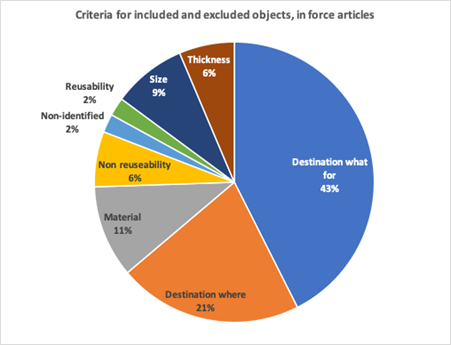
This graph represents, for all the in-force texts adopted by countries of the study, the criteria primarily used to define plastic bags concerned by the regulation[42]. The comparative, qualitative, quantitative and multicriteria analyses developed in this work are enabled and empowered by the use of a custom relational database, developed by the authors. This database enables to take a step back from the sole analysis of the legal text one at a time, and highlight trends along a set of characteristics.
The most eye-catching in this graph is the large part of ‘destination’ criteria representing two thirds of the objects whereas the characteristic-based definition represent only a third of the objects. By ‘destination’ is understood here all the plastic bags which are defined by their purpose, their use rather than their characteristics. Two sub-categories stand out: a use defined as ‘where’ the bag can be available (a) and as ‘what goods’ can the bag transport (b).
- ‘Where’ as a constituent element of the use
Plastic bags are used to transport a good from a place to another. The regulation of ‘where’ these bags are available constitute, for some countries, a criterion to determine ‘if’ plastic bags can be used with or without specific restrictions.
In England, Scotland[43] and Ireland[44], specific rules apply for bags “used to contain a purchase made on board a ship, train, aircraft, coach or bus”[45]. Prisons and hospitals are referred to as areas where plastic bags can specifically be used in Scotland[46]. Bags at retail outlets or at supermarket checkouts are also the object of specific regulations in Senegal[47], France[48], and Ireland[49].
In addition to ‘where’ the bag is available, ‘what goods’ can be transported appear as a common criterion used to define plastic bags.
- ‘What goods’ as a common component of the use
One could ask what is the commonality between a blade, a live aquatic creature, seeds, raw meat or fish, ice and medicine. The answer lies in the analysis of plastic bag regulation in Ireland, Cape Verde, Scotland and England. In these four entities, some plastic bags are defined by their predestination to transport one of these goods. Specific rules apply to these plastic bags, mostly exceptions to a specific instrument.[50]
The transport of fresh fish, poultry and meat is the most common criteria, that can be found in Cape Verde[51], Ireland[52], Scotland[53] and England[54]. In Scotland, these bags must be of a certain size[55]. Ice is a Cape Verde specificity[56], while blades (unpacked axe, knife or blade) bags and the transport of live aquatic creatures and medicine in plastic bags seem only to be a concern in the United Kingdom[57]. The transport of bulk and unpacked goods or products can also benefit from a plastic bag in Ireland[58], Scotland[59] and England[60].
The definition of the studied object is the first step to compare the strategies developed by different countries. Already, complexity arises, highlighting the challenges of a comparative analysis. Interestingly, a commonality emerges from this definition hubbub: plastic bags are dominantly considered as a necessity to regulate rather than as an object to eliminate: the legislators are more focused on where and what goods the bags will transport rather than on its intrinsic characteristics.
The articulation of all these definitions of plastic bags with the regulation instruments is key to picture the strategies developed by our case study countries to tackle plastic pollution. It is the next step of our demonstration.
II. A complete toolbox: scope of the instruments
Two elements together constitute what we call here the scope of the instruments: the type of instrument, and the types of objects included in or excluded from the instrument. Analysing these elements separately or simultaneously provides a fruitful understanding of the rationale followed by countries in their efforts to regulate plastic bags. In our case study, the type of instrument provides an insight (A) enlightened by the typology of what objects are included or excluded from the rule (B).
A) Type of instrument, useful insights into plastic bag regulation strategies
The choices countries made in regard to the types of instruments provide a first insight into differentiated plastic bag regulation strategies, through the modulation of the instruments’ scope. Our relatively small sample of countries offer a diversity of perspectives on which are the best instruments to regulate plastic bags. Three groups emerge: “command-and-control” (i), “economic incentive” (ii) and “command, educate and incentive” (iii).
- ‘Command-and-control’: a civil law perspective?
“Command-and-control” refers to a type of binding instrument leaving a very shallow leeway for actors’ adaptation[61]. The flagship instrument of this category is the ban.
The only fact that a ban exists in a country doesn’t mean that the protection is maximal. The types of behaviours and objects banned—and exempt from the ban—are central to the appreciation of the protection of the environment guaranteed by the country’s legal texts. Adding up the degree to which the texts are implemented and enforced leaves room for analyses which will not be addressed here.
In our sample, three countries have based their strategy to fight plastic pollution on the ban of some plastic bags: France, Senegal and Cape Verde.
In Senegal, since 2020, plastic bags are banned at supermarket checkouts[62]. Two categories of bags are excluded from this ban: bags found at retail outlets[63] and bags made of a material “designed in such a way that it is not easy for the consumer to replace the component or components.”[64].
This example is instructive on how a clear instrument—here a ban—can get profoundly confusing in its implementation and enforcement as it is difficult to delineate its outline. While the non-replacement criterium is obscure, the difference between checkout bags and retail bags is confusing as their definitions are very close[65]. The main difference between the two seems to lie in the types of goods transported. Retail bags are intended to protect and transport food, while checkout bags, which are prohibited, are intended to transport any good or product. The controllability of this instrument might be challenging, specifically in case of reuse of a retail bag for checkout purposes.
The sample of countries analysed here is too small to draw conclusions on the types of country preferring bans to other regulation instruments. We can nonetheless observe that all the countries of the sample belonging to the civil law tradition that have adopted plastic bag regulations opted for this approach[66].
- ‘Economic incentive’: a common law perspective?
In Ireland, England and Scotland, taxation is the only instrument used to regulate plastic bags. Ireland was the first country of this study and of this trio to regulate plastic bag, back in 2001[67]. Scotland followed in 2014[68] and England in 2015[69]. The approaches of these three countries are very close but nonetheless differentiated.
In Ireland the taxation commenced on March 4th, 2002 concerned both the commercialisation or distribution of plastic bags. Numerous exceptions to this rule are listed in the article 5 of the 2001 Statutory Act: bags solely used to transport fresh fish, poultry or meat, ice or cooked unpacked food, bags designed for reuse or bags used to contain goods or products sold on board a ship or aircraft or in certain areas of ports or airports. These exceptions to taxation, which can roughly be found in England[70] and Scotland[71] and enhanced with new categories, raise a few questions. If exceptions to a ban can be justified by the impossibility to find credible alternatives to some usages, taxation doesn’t deprive the users from the benefit of its object. Taxation is rather a matter of incentive than constraint. Thereof, why shouldn’t this incentive be applied to such objects?
We can observe that only common law countries have chosen taxation as a flagship instrument of their strategy to regulate plastic bags. This result should be tempered by the fact that both Senegal and Cape Verde, at some point, relied on taxation. In Senegal, plastic bags thicker than 30 microns used to be taxed in the first law regulating plastic bags[72]. Facing enforcement issues, this instrument has been abandoned in 2020. In Cape Verde, taxation has been used as a transition-instrument towards the ban of plastic bags[73].
- ‘Command, educate and incentive’: a Cape Verdean melody
The originality of the Cape Verdean approach lies in the combination of three types of instruments: command-type, education-based and incentives. These three types of instruments are used for different purposes, in a symbiotic perspective.
The 2015 lei ban the production and importation of ‘conventional’ plastic bags[74] since July 1st 2016[75]. The commercialisation and utilisation of these same bags enters into force six months later, on January 1st 2017. These two bans call for several comments.
First, the legislators left six months for producers to legally sell their products after the ban on production/importation. This delay may indirectly and paradoxically contribute to enhanced environment protection. Producers may be more likely to comply respect a rule if they have the feeling that their constraints have been taken into account[76].
Second, two categories of objects are excluded from this ban: biodegradable plastic bags[77] and bags used for specific purposes. Biodegradable bags are referred to as “inoffensive for the environment”[78], and defined as “plastic bags which are not produced from hydrocarbons of fossil origin and whose material may be subject to composting processes”[79]. Bags “used exclusively for packaging fresh fish, meat and poultry or fresh products thereof, fruit and vegetables and ice”[80] are also excluded from these two bans: both production, and commercialisation/use. The objective of this instrument is to eradicate or at least minimize the use of objects considered as noxious for the environment. The first exception (on biodegradable bags) is justified by the perception that this material is harmless. Even if the second exception isn’t justified, the list of allowed usages leads to consider this choice constrained by practical (cf. transport of ice) or hygiene perspectives (cf. transport of fresh fish or poultry). The necessity to use plastic bags to transport fruits and vegetables could be questioned.
Education is the second facet of the Cape Verdean strategy to tackle plastic pollution. Environmental associations are encouraged to “develop active consumer awareness campaigns on the importance of reducing consumption of conventional plastic bags, including through the reuse and use of recycled bags and/or bags with lower impacts on the environment”[81]. For this purpose, legislators offer governmental funding to associations, through the Environment Fund[82]. Additionally, the government must carry out awareness-raising campaigns[83]. Last but not least, “economic agents with headquarters or a permanent establishment in the national territory, who carry out both wholesale and retail trade, whether formal or informal, or engage in industrial activity” in relation with plastic bags must promote “environmental awareness among employees and consumers to promote responsibility for environmental protection”[84].
The taxation transition period works in symbiosis with the other two instruments. The ban is here to cut the tap of a pollution source. At the same time, legislators have in mind that such a constraint on people’s habits and behaviours can be enforced only if people understand why and are transitorily led to adopt alternative means, find alternative resources. Awareness raising and taxation here endorse this role. The focus put by the 2015 lei on awareness raising particularly noticeable, as Cape Verde is the only country of this sample to adopt this approach.
B) Criteria used to include / exclude objects from the regulation
The analysis of the objects included in (1) and excluded from (2) regulative instruments is the next and last step of this demonstration. Empowered by the analytic facilities enabled by the exploitation of the relational database developed for this research project, these results highlight differentiated strategies employed by countries banning or taxing plastic bags.
- The “selling spot”, a common criterium to include objects in the regulation
These graphics are extracted from the database compiling legal texts of the case study countries. Graphic 2 shows the types of objects that are included in regulations be they banning or taxing plastic bags. Graphics 3 and 4 offer the same perspective for respectively bans and taxations. These graphic representations provide a clear perspective in the types of criteria used in the different countries to ban or tax plastic bags.
First, comparing graphic 2 with graphic 1, we can observe that bags are mainly included in regulative instruments along the destination ‘‘where’’ criterium and other criteria related to the physical characteristics of bags (material, size, thickness, and reusability). The destination ‘‘what for’’ criterium has completely disappeared, whereas it represented 43% of the criteria used to define objects both included and excluded.
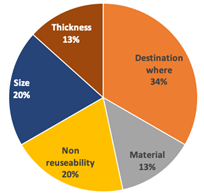
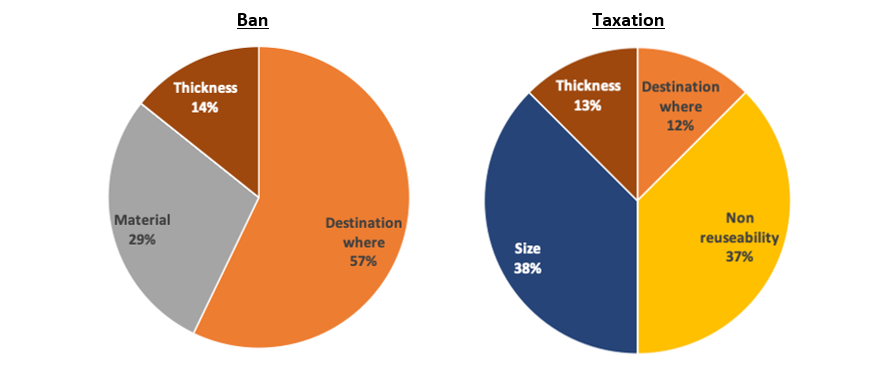
Graphic 4: Included carrier bags in taxation per type, in force articles. n=8
Comparing graphics 3 and 4 offers complementary perspectives on the differentiated strategies between bans and taxation. Three criteria are used to include objects in bans: destination ‘‘where’’, material and thickness. The destination ‘‘where’’ criterium is the leading criterium, reaching 57%. In this approach, the entry point of the legislation is less related to the characteristics of the bags in themselves rather than to where the bags will be available.
This strikingly contrasts with criteria used for taxation: ‘‘destination where’’ is the weakest criterium, way behind size (38%) and non-reusability (37%), with thickness in between (13%). Non-reusability and thickness criterium are strongly linked: the aim is to limit single use of bags, and reduce consumption of plastic. But what about size? What is the link between reduction of the use of plastic bags, protection of the environment and the size of the bags? The question remains open.
- The use, a common criterium to exclude objects from the regulation
The criteria used to exclude objects from a regulative instrument are equally instructive. Following the same scheme as for included objects, graphic 5 represents all the criteria used to exclude, regardless of the type of instrument. Graphics 6 and 7 respectively distinguish between ban. and taxation.
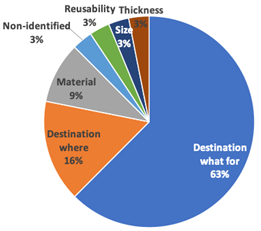
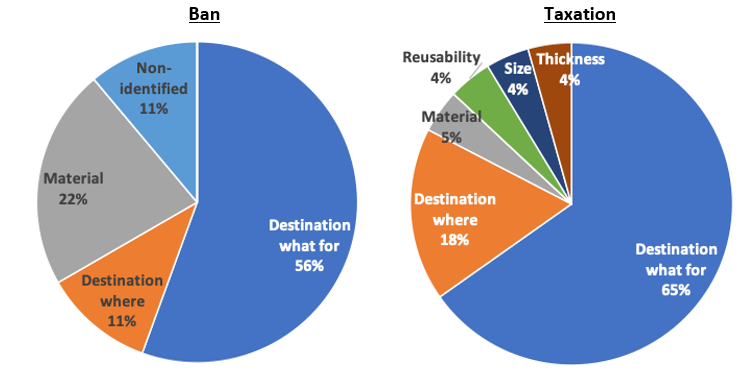
Graphic 7: Included carrier bags in taxation per type, in force articles. n=23
The first difference between graphic 2 and 5 lies in the number of objects. There are more than twice as much objects excluded from regulative instruments than objects included. This lies in the fact that legislators provide far more details on exclusion rather than on inclusion. The second stark difference is on the types of objects represented in each graph. Whereas the destination ‘‘what for’’ criterium is absent from included objects (graphic 2), it is predominant for excluded objects (graphic 5), representing 63% of criteria used to exclude. The rest is comprised of destination ‘‘where’’ (16%) and other criteria related to the physical characteristics of bags (material, reusability, size, and thickness).
The distinction between ban and taxation is less striking here. For both, the destination ‘‘what for’’ criterium is the leader, followed by destination ‘‘where’’ and material. Taxation additionally rely on other criteria related to the physical characteristics of bags (material, size, and thickness) to exclude some bags from taxation.
In all countries where plastic bags are banned or taxed, there are numerous exceptions to limit the impact of these regulations. Exceptions are common in law, general rule to a complex reality. However, by their recurrence or their amplitude, they can go against the validity of the rule or even become the rule[85].
The quantitative only basis to analyze included/excluded objects is therefore insufficient to capture the complexity of the regulation and to conclude on the potential of protection offered by these texts. They must be completed by qualitative analyses, offering a perspective on the scope of the exclusion, complementary to their number[86].
Conclusion
The work presented here is a mere insight into a vast opening research field. Both the analysis of the regulations of plastic bags and the numerical approach to environmental law would deserve further research. The work developed here must also be completed by the analysis of the forcefulness of the texts and instruments, through implementation and enforceability (controls and sanctions). This work is currently underway.
Related to plastic bags, an open question would be to determine whether the reduction of the dose enabled by the restrictions of the use of plastic bags is sufficient, a first step, or purely cosmetic.
The first hypothesis underpins that restriction of uses significantly curbs the production/use of plastic bags and thus the pollution curve attributable to plastics. This hypothesis is considered as unlikely due to the number of exceptions, and the fact that plastic bags are only a drop in an ocean of plastic.
For the second hypothesis, the restriction of the use of plastic bags would act as a Trojan horse in the mind of consumers and producers. The wake-up call stirred by the regulation of bags would question the preponderance of plastic in its single-use character. This thesis could be based on the concomitant/successive adoption of restrictions on the use of other single-use plastics (cotton swabs, cutlery, plates…) for example in France or in Senegal.
For the third hypothesis, the current regulations would only be cosmetic, as the regulations could easily be circumvented to promote more harmful practices that weren’t anticipated by the legislators, through the positive choice of some actors. Additionally, the regulation could have pervert effects which are not the result of a positive choice, but exist de facto.
Answering these hypotheses would require further research.
Additionally, further research would be required to determine whether these regulations are enforced on the ground, and to which extent their enforcement contribute to the eradication of plastic pollution.
Odeline Billant et Marie Bonnin, « Regulating plastic bags along the Atlantic coast: a numerical experiment in environmental law », Confluence des droits_La revue [En ligne], 12 | 2022, mis en ligne le 16 décembre 2022. URL : https://confluencedesdroits-larevue.com/?p=2113
[1] D. Azoulay, P. Villa, Y. Arellano et al., « Plastic Threatens Human Health at a Global Scale – New Report », Washington DC, Center for International Environmental Law (CIEL), 2019, p. 51.
B. Worm, E. B. Barbier, N. Beaumont et al., « Impacts of Biodiversity Loss on Ocean Ecosystem Services », Science, 314, November 2006, no 5800, p. 787‑790.
[2] S. Newman, E. Watkins, A. Farmer et al., « The Economics of Marine Litter », in Bergmann Melanie, Gutow Lars et Klages Michael (éd.), Marine Anthropogenic Litter, Cham, Springer International Publishing, 2015, p. 367‑394, p. 381.
[3] This article is a glimpse of the research developed by (anonymous). The PhD thesis is itself a pilot contribution to a larger research project on numerical approaches to environmental law (anonymous).
The countries have been selected on the basis of a set of criteria (convergence in engagement for the protection of the environment, divergence along legal traditions, political organizations, socioeconomic characteristics, etc.). For unitary countries (France, Senegal, Cape Verde and Ireland), legal texts considered as part of the analysis cover the entire territory. For Federal countries of this study (United States of America, United Kingdom and Brazil), the regulation of plastic bags lies under the jurisdiction of each State, not at the Federal level. As such, the content of the rule can vary greatly inside a Federal country. Time and the ambition to compare the strategies of different countries in front of a single pollution source required to select two States per Federal entity. Florida and Texas are the two States for the United States of America; England and Scotland for the United Kingdom; and the State of Pernambouco and Sao Paulo for Brazil
[4] This approach is embodied in beach cleanups or by projects like the Manta led by the Sea Cleaners (https://www.theseacleaners.org).
[5] This approach is for example promoted by the recycling industry.
[6] This idea ties up with the zero-waste movement’s adage saying that the best waste is the one that isn’t produced. In French « Le meilleur déchet est celui que l’on ne produit pas ».
[7] C. Moore, Plastic Ocean: How a Sea Captain’s Chance Discovery Launched a Determined Quest to Save the Oceans, [s. l.], Penguin, 2011, 291 p.
[8] Ireland Statutory Instrument n°36 of 2001, Waste Management (amendment) Act, 17th of July 2001 and Ireland Statutory Instrument No. 605/2001 — Waste Management (Environmental Levy) (Plastic Bag) Regulations, 2001, Given under the Official Seal of the Minister for the Environment and Local Government this 19th day of December 2001.
[9] D. Knoblauch, L. Mederake et U. Stein, « Developing Countries in the Lead—What Drives the Diffusion of Plastic Bag Policies? », Sustainability, 10, Multidisciplinary Digital Publishing Institute, June 2018, no 6, p. 1994.
[10] Statutory Instrument No. 161 of 2014, The Single Use Carrier Bags Charge (Scotland) Regulations, 3rd June 2014.
[11] Statutory Instrument No. 776 of 2015, The Single Use Carrier Bags Charges (England) Order 2015, 19th of March 2015
[12] Loi n° 2015-09 du 04 mai 2015 relative à l’interdiction de la production, de l’importation, de la détention, de la distribution, de l’utilisation de sachets plastiques de faible micronnage et à la gestion rationnelle des déchets plastiques, JO n°6859 du samedi 04 juillet 2015.
[13] Loi n°2015-992 du 17 août 2015 relative à la transition énergétique pour la croissance verte, JORF n°189 du 18/05/2020.
[14] Loi n ° 99/VIII/2015 du 21 aout 2015 établissant l’interdiction de la production, de l’importation, de la commercialisation et de l’utilisation des sacs en plastiques, BO n°51 du 27/08/2015 pp. 1600-1603.
[15] The city of Sao Paulo – with a population greater than Senegal- has adopted a law and a decree regulating plastic bags respectively in 2011 (Lei No 15.374 de 18 de Maio de 2011) and a decree (Decret nº 55.827 de 6 de Janeiro de 2015). The municipal level of regulation is excluded from this study, for time reasons. Thus, these regulations do not appear in this study.
[16] The city of Recife has also adopted a regulation in 2008 (Lei no 17.475/2008 Dispõe sobre as sacolas e sacos plásticos utilizados pelos estabelecimentos comerciais e órgãos municipais no âmbito do município do Recife), and another in 2011 (Lei no 17.733/2011. Obriga os hipermercados, supermercados, mercados e estabelecimentos congêneres a disponibilizar caixa preferencial aos consumidores que utilizarem sacolas retornáveis). The municipal level of regulation is excluded from this study, for time reasons. Thus, these regulations do not appear in this study.
[17] Lei Nº 16559 de 15/01/2019, Publicado no DOE – PE em 16 jan 2019.
[18] A bill to be entitled an Act relating to the imposition of a fee for certain plastic bags provided to customers by retailers to fund a grant program to support local recycling efforts. H.B. No.1877.
[19] A bill to be entitled an Act relating to the prohibition of plastic carryout bags and straws; creating s. 509.235, F.S.; defining terms; prohibiting a store or food service business from providing to a customer a carryout bag made of plastic film; prohibiting a food service business from selling or providing to a customer a single-use plastic straw; providing an exception; providing penalties; providing an effective date.
[20] See R. Baldwin, M. Cave and M. LODGE, Understanding Regulation: Theory, Strategy and Practice, Second Edition., Oxford, Oxford University Press, 2012, 548 p., p.68 on Regulatory Failure
See J. Bétaille, Les conditions juridiques de l’effectivité de la norme, Limoges, 2012, 767 p.
[21] M. Siems, « Numerical Comparative Law: Do We Need Statistical Evidence in Law in Order to Reduce Complexity », Cardozo Journal of International and Comparative Law, 13, 2005, p. 521‑540.
[22] M. Prieur, Les indicateurs juridiques, outils d’évaluation de l’effectivité du droit de l’environnement, IFDD, 2018, 160 p.
[23] M. Siems, « Measuring the Immeasurable: How to Turn Law into Numbers », in Faure Michael et Smits Jan (éd.), Does Law Matter? On Law and Economic Growth, Cambridge, United Kingdom, Intersentia, 2011, p. 115‑136.
[24] Article 3, Cape Verde 2015 lei n°99/VIII, above mentionned. Translated. In the text: « b) “Sacos de plástico convencionais”, os sacos de polietileno (de fórmula química (– CH2 –CH2-n de alta densidade (PEAD) e de baixa densidade (PEBD) ».
[25] to the exception of Linear Low Density Polyethylene (LLDPE), more resistant than HDPE and LDPE
[26] Plastic is considered as “a material consisting of a polymer to which additives or other substances may have been added and which can function as a main structural element of final products, with the exception of natural polymers which have not been chemically modified”, article 3 Senegal 2020 loi. Translated. In the text: « matériau constitué d’un polymère auquel peuvent avoir été ajoutés des additifs ou d’autres substances et qui peut fonctionner comme un élément structurel principal de produits finaux, à l’exception des polymères naturels qui n’ont pas été chimiquement modifiés ».
[27] Article 9, Ireland 2001 Statutory Instrument n° 36, above mentioned.
[28] Regulation n°3, Scotland 2014 Statutory Instrument No. 161, above mentioned.
[29] Article 2 Cape Verde 2015 lei n°99/VIII, above mentioned,consider biodegradable bags as “inoffensive for the environment”. Translated. In the text “os sacos degradáveis e biodegradáveis cuja inocuidade para o ambiente”.
[30] Article 75 of France 2015 loi n°992, above mentioned, « Un plastique oxo-fragmentable est dégradable mais non assimilable par les micro-organismes et non compostable conformément aux normes en vigueur applicables pour la valorisation organique des plastiques. ». In English “An oxo-fragmentable plastic is degradable but not assimilable by micro-organisms and not compostable in accordance with the standards in force applicable for the organic recovery of plastics.”
[31] Article 75 of France 2015 loi n°992, above mentioned.
[32] S. Rayne, « The need for reducing plastic shopping bag use and disposal in Africa », African Journal of Environmental Science and Technology, 3, 2008, no 3, p. 3.
[33] Statute 2, England 2015 Statutory Instrument n°776, above mentioned.
[34] Article 1, Décret n° 2016-379 du 30 mars 2016 relatif aux modalités de mise en œuvre de la limitation des sacs en matières plastiques à usage unique, JORF n°0076 du 31 mars 2016.
[35] Regulation n°3, 2014 Scotland Statutory Instrument n°161, above mentioned.
[36] Article 2, Senegal 2015 loi n°09, above mentioned.This law has been revoked since, Senegalese legislators arguing that this rule was inapplicable in practice, as Senegalese controllers were not equipped of micrometres (Instrument used to measure microns) as explained in the Preamble to the Loi n°2020-04 du 08 janvier 2020 relative à la prévention et à la réduction de l’incidence sur l’environnement des produits plastiques, publiée dans le Journal officiel n°7206 du 20/01/2020.
[37] Article 5, Ireland Statutory Instrument No. 605/2001, above mentioned.
[38] Article 160, Pernambouco 2019 lei, above mentioned.
[39] Ireland, England, Scotland. See also Statute 2, England 2015 Statutory Instrument n°776, above mentioned; Statutory Instrument and Regulation 3 of Scotland 2014 Statutory Instrument n°161, above mentioned.
[40] Article 5, Ireland 2001 Statutory Instrument n°605, above mentioned.
[41] ‘n’ is the number of criteria used to define carrier bags in case studies.
[42] This graph covers both ‘included’ and ‘excluded’ objects. Distinction will be made thereafter on the criteria primarily used to define included and excluded bags, relatively to the instruments used (i.e. ban, taxation, etc.).
[43] Statute 1, Scotland 2014 Statutory Instrument n°161, above mentioned.
[44] The Irish definition is slightly more complex but the underlying idea is the same “d) plastic bags used to contain goods or products sold: (i) on board a ship or aircraft used for carrying passengers for reward, or (ii) in an area of a port or airport to which intending passengers are denied access unless in possession of a valid ticket or boarding card, for the purposes of carrying the goods on board the ship or aircraft referred to in subparagraph (i)”. Article 5, Ireland 2001 Statutory Instrument n°605.
[45] Statute 1, Scotland 2014 Statutory Instrument n°161, above mentioned
[46] Article 5, The Single Use Carrier Bags Charge (Fixed Penalty Notices and Amendment) (Scotland) Regulations 2015 no 159, 31st of March 2015.
[47] Article 3, Senegal 2020 loi n°04, above mentioned.
[48] Article 75 of France 2015 loi n°992, above mentioned.
[49] Article 3, Ireland 2001 Statutory Instrument n°605, above mentioned.
[50] Such as a ban or taxation. The scope of instruments is addressed in the second part of this article.
[51] Article 2, Cape Verde 2015 lei n°99/VIII, above mentioned.
[52] Article 5, Ireland 2001 Statutory Instrument n°605, above mentioned.
[53] Statute 1, Scotland 2014 Statutory Instrument n°161, above mentioned.
[54] Statute 2, England 2015 Statutory Instrument n°776, above mentioned.
[55] “a gusset not more than 125 millimeters wide, and is not more than— (i) 205 millimeters wide; or (ii) 458 millimeters high (including any handle)”, Statute 1, Scotland 2014 Statutory Instrument n°161, above mentioned.
[56] Article 2, Cape Verde 2015 lei n°99/VIII, above mentioned.
[57] England see Statute 2, England 2015 Statutory Instrument n°776; Scotland see Statute 1, Scotland 2014 Statutory Instrument n°161, above mentioned.
[58] Article 5, Ireland 2001 Statutory Instrument n°605, above mentioned.
[59] Statute 1, Scotland 2014 Statutory Instrument n°161, above mentioned.
[60] Statute 2, England 2015 Statutory Instrument n°776, above mentioned.
[61] M. Böcher, « A theoretical framework for explaining the choice of instruments in environmental policy », Forest Policy and Economics, 16, Elsevier, 2012, no C, p. 14‑22.
[62] Checkout bags defined as “a bag supplied to consumers at the point of sale of goods or products and which is intended for the transport of said goods or products”. In the text « sac fourni aux consommateurs dans les points de vente des marchandises ou des produits et qui sont destinés au transport desdits produits ou desdites marchandises », article 3, Senegal 2020 loi n°04, above mentioned.
[63] Retail bags defined as “plastic bags intended and used at retails to package foodstuffs in order to protect them, to allow their handling or transport from the producer or seller to the consumer, and to ensure their presentation.”. Translated. In the text: « sacs plastiques destinés et utilisés dans les points de vente pour emballer des denrées alimentaires afin de les protéger, de permettre leur manutention ou leur acheminement du producteur ou du vendeur au consommateur, et d’assurer leur présentation ».Article 5, Senegal 2020 loi n°04, above mentioned.
[64] Translated. In the text: « Sont exclus du champ d’application de la présente loi, les produits dont un ou plusieurs composants sont des produits constitués ou fabriqués à partir de matières plastiques à condition que le produit principal soit conçu de manière à ne pas permettre facilement le remplacement du ou des composants par le consommateur. », Article 2, Senegal 2020 loi n°04 , above mentioned.
[65]Checkout bags are defined as “intended for the transport of said goods or products” and retail bags as used “to package food in order to protect them, to enable them to be handled or transported from the producer or seller to the consumer, and to ensure their presentation.” See notes 60 and 61 for the full definition and references.
[66] This doesn’t mean that all civil law countries choose to ban rather than tax, neither that all entities that have banned plastic bags belong to the civil law traditions. Many counter examples exist for both affirmations. As such, California bans plastic bags since 2014 and Bangladesh was the first country to ban plastic bags in 2002.
[67] Article 3, Ireland 2001 Statutory Instrument n°605, above mentioned.
[68] Regulation 6, Scotland 2014 Statutory Instrument n°161, above mentioned.
Interestingly, the Scottish regulation precise that single use bags made of paper or another non plastic material should be taxed just like single use plastic bags. This decision highlights the fact that alternatives to plastic bags also have an impact and shouldn’t be adopted with a blind eye. Changing habits from single-use (whatever the material) to multiple-use is here highlighted as the major challenge.
[69] Article 3, England 2015 Statutory Instrument n°776, above mentioned.
[70] Types of bags excluded from the taxation in England see Statute 2, England 2015 Statutory Instrument n°776, above mentioned.
[71] Types of bags excluded from the taxation in Scotland, see Statute 1, Scotland 2014 Statutory Instrument n°161, above mentioned.
[72] Article 3, Senegal 2015 loi n°09, above mentioned.
[73] In Cape Verde, taxation is used as a transitory measure to accompany consumers towards the total ban of conventional plastic bags. From the commencement of the 2015 lei in July 2015 to the ban of the utilisation of ‘conventional’ plastic bags in July 2017, these bags are charged. Article 7, Cape Verde 2015 lei n°99/VIII. The underlying idea is to make people understand that using plastic bags has a cost that was previously invisible.
[74] ‘Conventional plastic bags’ are defined as “polyethylene bags (chemically formulated (- CH2 -CH2-n high density (HDPE) and low density (LDPE)) which are used for the packaging of products purchased in retail outlets”. Translated: “ os sacos de polietileno (de fórmula química (– CH2 –CH2-n de alta densidade (PEAD) e de baixa densidade (PEBD) que têm a fi nalidade de acondicionamento de produtos adquiridos em estabelecimentos comerciais de venda ao público », article 3, Cape Verde 2015 lei n°99/VIII.
[75] Article 5, Cape Verde 2015 lei n°99/VIII, above mentioned.
[76] Article 12, Cape Verde 2015 lei n°99/VIII, above mentioned. The Cape Verdean lei enters into force in July 29th 2015. This leaves producers near to a year to find alternatives to the production of ‘conventional’ plastic bags. Producers are encouraged to progressively work towards this ban by a gradual reduction of the production / importation of plastic bags. A 60% reduction rate should be attained in 2015, to reach 100% by July 1st, 2016.
[77] Scientific evidence emerges to raise the alarm against biodegradable bags. They highlight the risk of pervert effects with a raise of consumption due to their consideration as inoffensive, but also the specific conditions needed for a bag to degrade, which are rarely found in the environment. The biodegradation of bags in microplastic is also a concern, just as emerging evidence on potential disruption of ecosystems due to the degradation of these types of bags. See for example T. Narancic et K. E. O’Connor, « Plastic waste as a global challenge: are biodegradable plastics the answer to the plastic waste problem? », Microbiology, 165, Microbiology Society, 2019, no 2, pp. 129‑137.
[78] Translated. In the text “os sacos degradáveis e biodegradáveis cuja inocuidade para o ambiente” Article 2, Cape Verde 2015 lei n°99/VIII, above mentioned.
[79] Translated. In the text “Sacos de plástico degradáveis ou biodegradáveis”, os sacos de plástico que não sejam produzidos a partir de hidrocarbonetos de origem fóssil e cujo material possa ser sujeito a processos de compostagem.”, article 3, Cape Verde 2015 lei n°99/VIII, above mentioned.
[80] This definition remains vague, and partly unsatisfactory as it leaves the door open for potential pervert effects Translated. In the text “Os sacos de plástico utilizados exclusivamente para acondicionar peixe, carne e aves domésticas frescas ou seus produtos frescos, frutas e legumes, bem como gelo.”, article 2, Cape Verde 2015 lei n°99/VIII, above mentioned.
[81] Translated. In the text « As associações ambientais devem desenvolver campanhas activas de sensibilização dos consumidores sobre a importância de redução dos consumos de sacos de plástico convencionais, nomeadamente através da reutilização e utilização de sacos reciclados e/ou com menores impactos para o ambiente. », article 18 Cape Verde 2015 lei n°99/VIII, above mentioned.
[82] Article 18 Cape Verde 2015 lei n°99/VIII, above mentioned. This Environment Fund is partly financed by the proceeds of the fines in case of non respect of the lei, which “are fully allocated to the financing of awareness raising and other activities for environmental protection among consumers”, (article 15 Cape Verde 2015 lei n°99/VIII, above mentioned). The Central Environment Service must also, “at least once a year on all islands, (…) carry out an awareness campaign to reduce the consumption of plastic bags” (article 9 Cape Verde 2015 lei n°99/VIII, above mentioned).
[83] “campaigns to disseminate and raise awareness about the rational use of degradable and or non-biodegradable material (…) [and] inform and empower citizens about possible alternatives that might replace non-degradable and/or biodegradable plastic packaging” article 14 Cape Verde 2015 lei n°99/VIII, above mentioned.
[84] Articles 4 and 13, Cape Verde 2015 lei n°99/VIII, above mentioned.
[85] O. Billant et M. Bonnin, « Vers l’interdiction des sacs plastique en Afrique atlantique : une analyse numérique en droit de l’environnement », Mondes en développement, n° 193, De Boeck Supérieur, mars 2021, no 1, p. 7‑25.
[86] Example: in a quantitative approach, an exception for bags used to transport axes counts the same as a bag used to transport fresh fruits. But more people transport fresh fruits than axes… An exception for ae-bags doesn’t have the same impact as an exception for fruit bags. Additionally, some entities, as England or Scotland provide extensive lists of specific exceptions, whereas others (such as Senegal) provide a small number of exceptions with a very large scope. Numbers only do not highlight this complexity.




